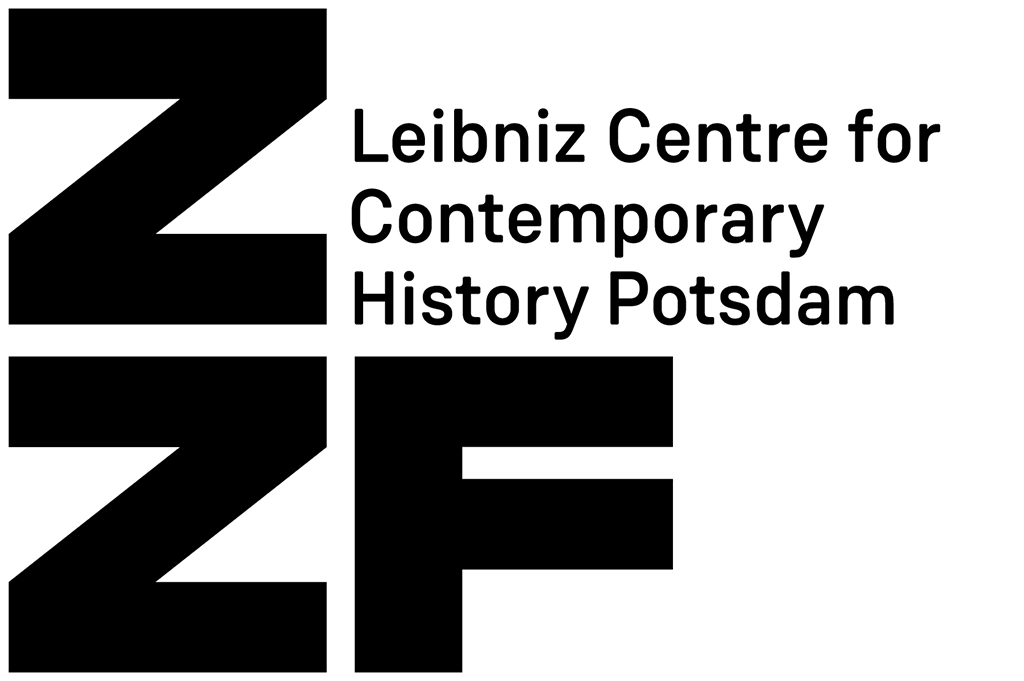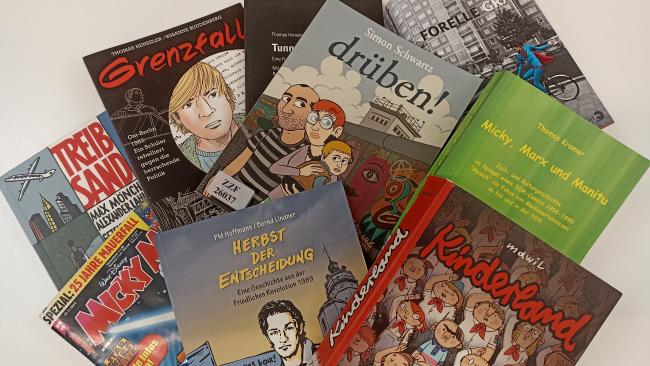Our third newsletter is dedicated entirely to books, as the Leipzig Book Fair begins today. Now, books usually have vast amounts of letters and – especially in our institute – are rarely colourful on the inside. But that doesn't have to be the case! There are also multicoloured books with lots of pictures. Even for adults! Even here with us! You don't believe us?
Then read: Comics Historical Sources and then our newsletter, in which we present comics about and within the GDR. And then you can come and browse through our comic, or as it is called today: graphic novel section, in all seriousness and with scientific vigour. We wish you lots of fun! Your library team
Olaf Schwarzbach: Forelle Grau [Trout Grey] (ZZF 26599)
It's hard to imagine Berlin's newspaper landscape without him, as various papers, as Zitty, Tip, Tagesspiegel, Zeit, Jungle World, Berlinerzeitung, have already printed some of his biting commentaries on gentrified East Berlin. Just in time for the book fair, OL has now published his autobiography, no: not drawn, but written down. Born in Berlin in 1965, Olaf Schwarzbach, known as OL, grew up in Potsdam. At the age of sixteen, he first came into contact with the Stasi, who henceforth called him Forelle - perhaps because of his surname, perhaps because his personality was as colourful as a rainbow trout. When the Stasi found copies of his system-critical comics during a search of an apartment exhibition, he burnt the original drawings and fled to the West. OL tells his very personal, tragicomic East-West story - because he is annoyed by stories and myths about the East that do not correspond to his memories at all, and because he sees many things differently.
Micky Maus Spezial: 25 Jahre Mauerfall (ZZF 26622)
The most famous comic figure of all is Mickey Mouse. Born in 1928, he has been delighting comic fans worldwide ever since. The issue published on 7 November 2014 contains a 16-page dossier on "25 years since the fall of the Berlin Wall". As the magazine creators relied on the research conducted by our institute, the ZZF is duly mentioned by name and with its logo. This probably unique fact deserves speech bubbles like "Aaaah!" "Waaahnsinn!" "Super!", which unfortunately we cannot adequately reproduce here. The included "celebration poster" shows the stars from Duckburg on the Wall: Donald, Scrooge and Daisy Duck, and of course Huey, Dewey and Louie, and Minnie Mouse. The Beagle Boys are busily collecting Wall bricks while Mickey Mouse and Goofy celebrate. Alongside the comic strips, brief paragraphs tell about the "Building of the Wall" and its fall, "Risky escapes" and the mass demonstrations, famous politicians talk about their "Memories of the day of joy", and one section invites readers to "Imagine the Wall still stood".
Kitty Kahane: Treibsand – eine Graphic Novel aus den letzten Tagen der DDR [Quicksand - a graphic novel from the last days of the GDR] (ZZF 26054)
Kitty Kahane not only illustrates cookbooks and children's books, but also occasionally designs the matching crockery. Her edgy style is reminiscent of the theatre posters of Volker Pfüller or Henning Wagenbreth and yet is as unmistakable as the singing voice of, say, Cyndi Lauper. For Metrolit Verlag, she drew the story of Tom Sandman, which the authors Alexander Lahl and Max Mönch came up with. Tom, a correspondent who has just returned home to New York from China, where he witnessed a massacre, is immediately sent back to a crisis area: to Berlin to report on the unrest in the GDR. Accompanied by a severe toothache and bad dreams, he travels to a country in decline and sleeps through the opening of the Wall.
Thomas Henseler: Tunnel 57 – eine Fluchtgeschichte als Comic [an escape story in comic form] (ZZF 26042)
From the perspective of an escape helper, the comic authors Thomas Henseler and Susanne Buddenberg tell the story of the construction of an escape tunnel in 1964 in divided Berlin: of the preparations on the West Berlin side, the digging of the 145 metre long tunnel to East Berlin, the opening of the tunnel and the successful escape on the first day and the dramatic events on the second day, which were to have serious consequences. Based on interviews with contemporary witnesses, original photos and documents, the authors have reconstructed the events surrounding Tunnel 57. The historical background is presented in a contribution by Maria Nooke, while interviews with an escape helper and his refugee girlfriend illustrate the events from their perspective. There are also supplementary materials for school lessons by René Mounajed and Stefan Semel..
Peter M. Hoffmann: Herbst der Entscheidung – eine Geschichte aus der Friedlichen Revolution 1989* [Autumn of Decision - a story from the Peaceful Revolution of 1989*] (ZZF 26038)
Leipzig in the autumn of 1989: 17-year-old high-school graduate Daniel, the son of parents loyal to the state, is ordered to commit to three years of military service in order to be able to study. He falls out with his father, runs away from home, immerses himself in the citizen's movement scene, falls in love with one of the protagonists and becomes increasingly caught up in the events of the Peaceful Revolution, which was to fundamentally change the GDR. Bernd Lindner's story about growing up and the awakening of political awareness in turbulent times was drawn with great attention to detail and a clear, almost harsh line by Peter M. Hoffmann; neither the RONDO coffee nor the "Titanic" Zone Gaby with her "first banana" are missing.
Simon Schwartz: Drüben! [Over there!] (ZZF 26037)
Born in Erfurt in 1982, the illustrator (self-titled) researched his parents' departure from the GDR to West Berlin for his debut comic and tells of the never-healing wound this decision caused. While his paternal grandparents were lifelong supporters of the socialist state, Simon Schwartz's parents' doubts about the system grew in the face of the state's rigid treatment of moderate critics of the regime. Without informing anyone, the young parents therefore applied to leave the country – and indeed: after various harassments, they were virtually expelled from the country in 1984 in a "rush action". As a result of this ‘betrayal’, the paternal grandparents refused any contact with their son and his family. Schwartz' uses a clear, almost sober drawing style to scrutinise the background to the family's non-communication. While the GDR was a protective space for the grandparents – the Jewish grandfather had to witness the deportation of many relatives to the Nazi extermination camps – it increasingly became an unbearable imposition for the next generation.
Mawil (d.i. Markus Witzel): Kinderland (ZZF 26032)
This colourful, almost 300-page album tells a classic coming-of-age story, only from a uniqe perspective. Because we are in the summer of 1989. In the GDR. Even before the major events in world politics unfold, much is already happening in the life of Mirco Watzke, an anxious little boy with glasses who is neither particularly handsome nor cool and certainly not brave. His nickname: Crybaby. This otherwise exemplary pupil of class 7a is in trouble with the annoying FDJ members and the only one who can help him seems to be a strange newcomer from the parallel class called Koslowski, an outsider, without a father and not even in the Thälmann Pioneers. He's tall and rough, but he gets on quite well with Mirco. And then there's this table tennis. The first thing Mirco is really good at. He even wants to organise a school tournament, which is to take place on 9th November of all days.
Thomas Kramer: Micky, Marx und Manitu (ZZF 23791)
The literary scholar Thomas Kramer first published two "Mosaik" fan books before completing his habilitation in 2002 with this study, which examines contemporary and cultural history in the mirror of a GDR comic, the "Mosaik"’. "This is the first attempt to systematically reconstruct the history of the creation and reception of popular culture and trivial literature in Germany over half a century and in different systems," wrote H-Soz-Kult. Kramer interviewed the long-time "Mosaik" author Lothar Dräger about his reading biography and emphasised the importance of Karl May in particular. And so it comes as no surprise that the Digedags follow in the footsteps of Winnetou and Old Shatterhand in the America series. Incidentally, the exhibition "Atze und Mosaik" curated by Thomas Kramer at the Academy of Fine Arts in Leipzig can be visited until 18th March. So if you're already at the book fair, you could stop by there...
„Schuldig ist schließlich jeder ... der Comics besitzt, verbreitet oder nicht einziehen lässt“ – Comics in der DDR: die Geschichte eines ungeliebten Mediums (1945/49-1990) ["After all, everyone is guilty ... who owns, distributes or does not allow comics to be collected" – Comics in the GDR: the history of an unloved medium (1945/49-1990)] (4° ZZF 4133)
The book tells of the diverse newspaper and magazine comics in the GDR, beginning in the 1950s with Werner Klemke, Erich Schmitt, Richard Hambach and others. A turning point was the anti-comic campaign of 1955, which ultimately led to the "Youth Protection Regulation" of 15th September 1955. The title of the work is also derived from this regulation, as it not only criminalised the production, distribution or import of so-called "trash and dirt products", but even the possession or non-delivery of (Western) comic products. From then on, corresponding printed products were called "picture magazines" in the GDR. The exhibition catalogue focuses on the (still) popular "Mosaik", but also includes "Atze", "Frösi" and the emerging fanzine scene of the 1980s. Noteworthy is the careful compilation of newspaper and magazine comics from the GDR for the period from 1945 to 1990.
Leichtmetall – Comics in der DDR: eine Dokumentation (4° UB 334)
In the last years of the GDR, there was a small scene that was fond of comic art and used the logistics available to it to publish very small print runs. Back in 1990, the journalist Volker Handloik honoured this scene with a large-format book that brought together illustrious artists, some of whom are renowned today, such as Leipzig-based Schwarwel (who invented the comic character Schweinevogel [pig bird] and designed a number of album covers for the band Die Ärzte), Ulf Graupner (who worked for "Mosaik" and the Abrafaxe magazines after 1993, and who drew "Ritter Runkel" and many more), and many others. BECK (also from Leipzig, received the German Caricature Prize for the fourth time in 2013 and currently draws for publications like Zeit, TAZ, Eulenspiegel, and Cicero, among others), Anke Feuchtenberger (who has been publishing great albums that delve into dark surreal worlds since 1993. The genre "graphic novel" was invented for illustrators like her!), ATAK (who is co-founder of the comic group Renate and is now occasionally appointed as a visiting professor for illustration)....
(12.03.2015)

